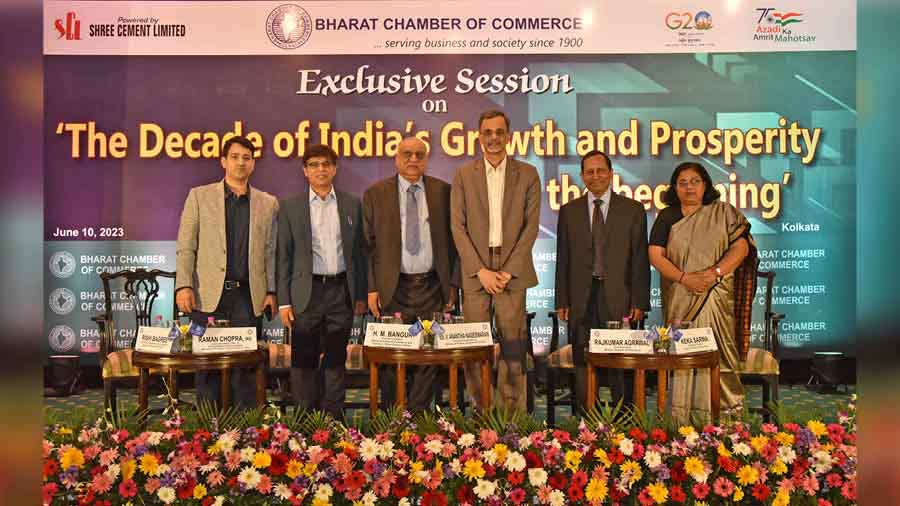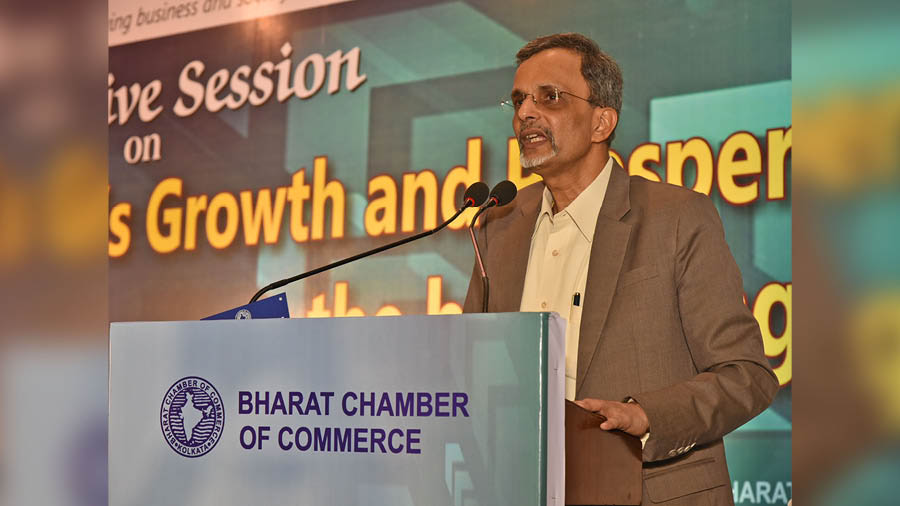The chief economic advisor, V. Anantha Nageswaran, said India’s GDP growth in FY23 may come in higher than 7.2 per cent once finalised in February 2026.
He was speaking in Kolkata at a session titled “The Decade of India’s Growth and Prosperity – the Beginning” organised by the Bharat Chamber of Commerce on Saturday.
“India’s GDP growth estimates are presented six times, the final estimate for FY23 will actually be with us in January-February 2026. And my expectation and belief are that when the final number for FY23 is frozen in February 2026, it will be more than 7.2 per cent,” the CEA said.
Those present at the session were Rajkumar Agarwal, vice-president, Bharat Chamber of Commerce, H.M. Bangur, former president of Bharat Chamber of Commerce and the chairman of Shree Cement Limited, Raman Chopra, IRS, joint secretary (TPL-II), Central Board of Direct Taxes, Minister of Finance and Rishi Bagree, chairman of programmes, sub-committee, Bharat Chamber of Commerce.
“This is just the first reliable estimate of the GDP growth,” Nageswaran said. As more and more data is available, further revisions would be even more upside from 7.2 per cent as the momentum of the economy is “quite strong”, he said.
“While the economies of several nations are facing headwinds, we, in India, are fortunate to be based in forward-looking policies,” Agarwal said in his welcome address. This was followed by a presentation of the theme by HM Bangur who focused on India’s growing economic prowess and how it has contributed to the growth of the private sector.
Chopra remarked that despite the large reduction in taxes, the government has been able to mop up a large revenue over the past few years because of the government’s focus on “voluntary compliance”. This encourages citizens to pay taxes of their own volition, requiring minimal interference from the government.

V. Anantha Nageswaran discussing India's economic growth
Steady Growth
“The purpose of the presentation is not only to share the good news of India’s economic growth after the pandemic but also to share with you that we are aware of the responsibility and have to carry this growth forward into the next 20 to 30 years,” Nageswaran said.
Referring to the GDP, Nageswaran said, “There were some quarters when the numbers were in the lower percentages but this was due to the previous year’s revision on the higher side so the base effect depressed the third quarter growth. Moreover, the oil price increase and the increase in the interest rates also affected the GDP growth. But the underlying momentum of the economy was strong. And if you look at the other countries, India’s growth in the fourth quarter was higher than in several leading nations, developing and developed,” he remarked.

V. Anantha Nageswaran being felicitated by H.M Bangur
Positive indication for agriculture, industries and private consumption
“Agriculture is growing at 4 per cent and even if we have concerns about the monsoon and the El Nino effect, it is good to know the storage in reservoirs compared to the 10-year average is running at 24% above the ten-year average,” Nageswaran said.
Of private consumption and GDP
Private consumption as a share of GDP was at a 16-year high, the CEA added. The post-pandemic catch-up was mainly driven by urban consumption, Nageswaran said, adding that the classification of what constitutes rural and urban India also keeps changing.
“Some pockets of consumption are not growing as strongly as other pockets (of consumption) but overall, the aggregate consumption growth in the economy has caught up with the long-term trend which means that the pandemic-induced consumption slowdown is a thing of the past,” he said. On the rural demand, he said it was beginning to turn around.
On AI and ChatGPT
Responding to a query on the impact of artificial intelligence (AI) tools like ChatGPT on jobs, he said this scenario could be a possible source of growth for India.
“Given our growth and given the fact that we are still climbing from lower middle income to middle income it actually opens up capacity and potential for our own IT-enabled enterprises to take on more assignments and more projects. So, it can be therefore employment generating rather than employment reducing at this point,” Nageswaran said.
On foreign investors
“Foreign portfolio investors are entering India after the first six months of the last FY when they were somewhat cautious. They are beginning to appreciate the macroeconomic stability, corporate profitability, and overall growth of the country. Foreign exchange reserves after dipping in the first half of FY 23, are now coming closer to $600 million and if we include forward cover positions it is already above $600 million covering more than 10 months of import,” he said.

From left: Rishi Bagree, Raman Chopra, H.M Bangur, V. Anantha Nageswaran and Rajkumar Agarwal
Managing Inflation
“India used to suffer from high inflation after three to four years of growth. This would lead to widening of the current account deficit, Central Bank raising interest rates and the currency collapsing. However, such overheating is now a thing of the past. In this cycle, India’s inflation peaked at 7.8%, the smallest deviation from the target of the 2-6% range and that is why RBI’s interest rates are some of the smallest in the world. We did not overspend during the pandemic era and the government took care of the essential needs of the population. Thus, the inflation overshoot was much smaller in comparison to other countries,” explained Nageswaran.
India’s digital transformation
“The digital transformation is not just for ease of payment but also to create digital footprints. Even the smallest vendor with a smartphone has a digital track record to show which gives them access to various government schemes and programmes. The Open Network for Digital Commerce provides the global marketplace for even the smallest enterprise, the Udyam portal for MSMEs, the E-Shram portal for informal workers so that they get welfare benefits, the PM SVANidhi scheme for street vendors to grow and become formal and account aggregators for all of us to allow with the click of a button to let our information to pass through different financial institutions so that can you can avail different financial products
and schemes,” remarked the Chief Economic Advisor.
The session came to a close with Nageswaran interacting with the audience and Rishi Bagree, chairman of the programmes sub-committee of the Bharat Chamber of Commerce delivering the vote of thanks.
Nageswaran was felicitated by HM Bangur while Chopra was felicitated by Rajkumar Agarwal.
